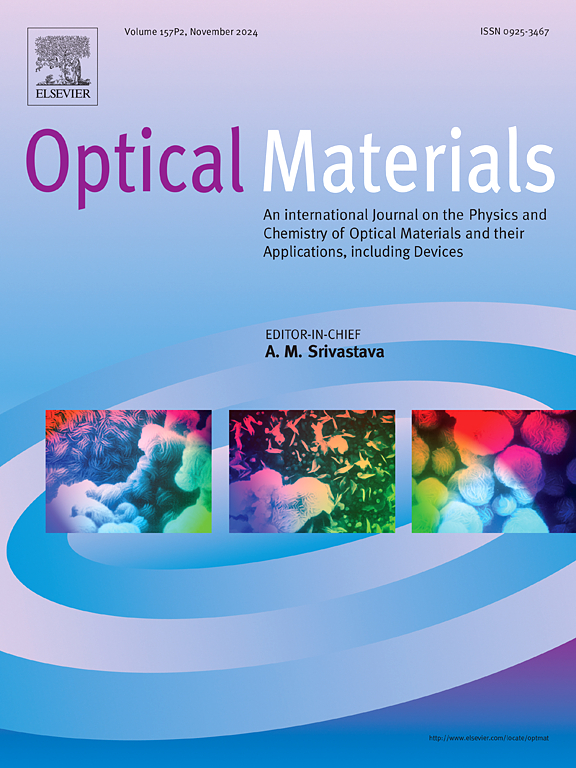A new rare-earth borate Sr3Dy2(BO3)4 and tunable luminescence properties of Sr3Dy2-2xEu2x(BO3)4 phosphors
IF 3.8
3区 材料科学
Q2 MATERIALS SCIENCE, MULTIDISCIPLINARY
引用次数: 0
Abstract
A new rare-earth borate Sr3Dy2(BO3)4 was obtained by high-temperature solution reaction at 950 °C and structurally characterized by single-crystal XRD for the first time. It crystallizes in the orthorhombic system (Pnma group, Z = 12) with cell parameters of a = 22.2265(3) Å, b = 15.8861(2) Å, c = 8.7096(1) Å, V = 3075.29(7) Å3. The compound features a complex 3D framework constructed by (Dy/Sr)On (n = 7, 8, and 9) polyhedra and BO3 planar triangles. Moreover, solid solutions of Sr3Dy2-2xEu2x(BO3)4 (0 ≤ x ≤ 0.2) were prepared via the solid-state reaction route. The obtained products were characterized by powder XRD/Rietveld refinement, SEM/EDS, IR/Raman, XPS, DRS, and photoluminescence techniques. It was found that all samples were in the yellow-white light region under excitation at 351 nm. Among them, Sr3Dy1.6Eu0.4(BO3)4 exhibits the CIE coordinates of (0.3292, 0.3536), close to the standard white-light illumination. When λex = 394 nm, as the Eu3+ content varies from x = 0 to 0.2, the emission color of Sr3Dy2-2xEu2x(BO3)4 can be adjusted from yellow-white (0.3280, 0.3834) to yellow-pink (0.5373, 0.3667). Thus, color-tunable and white emissions can be achieved by controlling the wavelength of the excitation light and the Eu3+/Dy3+ ratio. Meanwhile, the temperature-dependent analysis of Sr3Dy1.6Eu0.4(BO3)4 proved the high thermal stability, with the emission intensity at 150 °C remaining >75 % of its value at room temperature. These results indicate that Sr3Dy2-2xEu2x(BO3)4 has the potential as a single-phase white-emitting phosphor for w-LED applications.

新型稀土硼酸盐Sr3Dy2(BO3)4及Sr3Dy2- 2xeu2x (BO3)4荧光粉的可调发光性能
采用950℃高温溶液反应法制备了新型稀土硼酸盐Sr3Dy2(BO3)4,并首次采用单晶XRD对其结构进行了表征。晶型为正交晶系(Pnma基团,Z = 12),晶型参数为a = 22.2265(3) Å, b = 15.8861(2) Å, c = 8.7096(1) Å, V = 3075.29(7) Å3。该化合物具有由(Dy/Sr)On (n = 7,8,9)多面体和BO3平面三角形构成的复杂三维框架结构。通过固相反应制备了Sr3Dy2-2xEu2x(BO3)4(0≤x≤0.2)的固溶体。采用粉末XRD/Rietveld细化、SEM/EDS、IR/Raman、XPS、DRS和光致发光技术对所得产物进行了表征。在351nm的激发下,所有样品都处于黄白光区。其中,Sr3Dy1.6Eu0.4(BO3)4的CIE坐标为(0.3292,0.3536),接近标准白光照明。当λex = 394 nm时,随着Eu3+含量在x = 0 ~ 0.2范围内的变化,Sr3Dy2-2xEu2x(BO3)4的发射色可以从黄白(0.3280,0.3834)到黄粉(0.5373,0.3667)之间变化。因此,可以通过控制激发光的波长和Eu3+/Dy3+的比例来实现颜色可调和白色发射。同时,对Sr3Dy1.6Eu0.4(BO3)4的温度依赖性分析表明,Sr3Dy1.6Eu0.4(BO3)4具有较高的热稳定性,在150℃时的发射强度保持在室温时的75%。这些结果表明Sr3Dy2-2xEu2x(BO3)4具有作为w-LED应用的单相白光荧光粉的潜力。
本文章由计算机程序翻译,如有差异,请以英文原文为准。
求助全文
约1分钟内获得全文
求助全文
来源期刊

Optical Materials
工程技术-材料科学:综合
CiteScore
6.60
自引率
12.80%
发文量
1265
审稿时长
38 days
期刊介绍:
Optical Materials has an open access mirror journal Optical Materials: X, sharing the same aims and scope, editorial team, submission system and rigorous peer review.
The purpose of Optical Materials is to provide a means of communication and technology transfer between researchers who are interested in materials for potential device applications. The journal publishes original papers and review articles on the design, synthesis, characterisation and applications of optical materials.
OPTICAL MATERIALS focuses on:
• Optical Properties of Material Systems;
• The Materials Aspects of Optical Phenomena;
• The Materials Aspects of Devices and Applications.
Authors can submit separate research elements describing their data to Data in Brief and methods to Methods X.
 求助内容:
求助内容: 应助结果提醒方式:
应助结果提醒方式:


